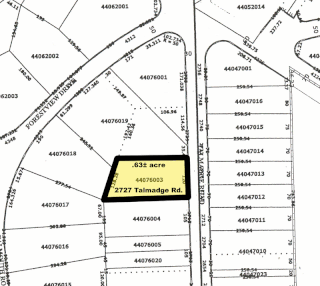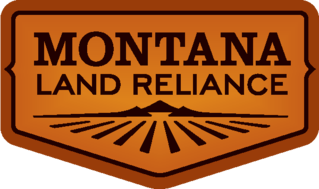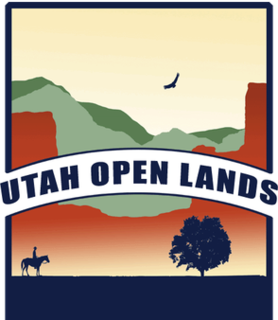Related Research Articles
In the United States, a conservation easement is a power invested in a qualified private land conservation organization or government to constrain, as to a specified land area, the exercise of rights otherwise held by a landowner so as to achieve certain conservation purposes. It is an interest in real property established by agreement between a landowner and land trust or unit of government. The conservation easement "runs with the land", meaning it is applicable to both present and future owners of the land. As with other real property interests, the grant of conservation easement is recorded in the local land records; the grant becomes a part of the chain of title for the property.
There are two distinct definitions of a land trust:

In the United States, a plat is a map, drawn to scale, showing the divisions of a piece of land. United States General Land Office surveyors drafted township plats of Public Lands Surveys to show the distance and bearing between section corners, sometimes including topographic or vegetation information. City, town or village plats show subdivisions into blocks with streets and alleys. Further refinement often splits blocks into individual lots, usually for the purpose of selling the described lots; this has become known as subdivision.
Natural Resources Conservation Service (NRCS), formerly known as the Soil Conservation Service (SCS), is an agency of the United States Department of Agriculture (USDA) that provides technical assistance to farmers and other private landowners and managers.
Environmental mitigation, compensatory mitigation, or mitigation banking, are terms used primarily by the United States government and the related environmental industry to describe projects or programs intended to offset known impacts to an existing historic or natural resource such as a stream, wetland, endangered species, archeological site, paleontological site or historic structure. To "mitigate" means to make less harsh or hostile. Environmental mitigation is typically a part of an environmental crediting system established by governing bodies which involves allocating debits and credits. Debits occur in situations where a natural resource has been destroyed or severely impaired and credits are given in situations where a natural resource has been deemed to be improved or preserved. Therefore, when an entity such as a business or individual has a "debit" they are required to purchase a "credit". In some cases credits are bought from "mitigation banks" which are large mitigation projects established to provide credit to multiple parties in advance of development when such compensation cannot be achieved at the development site or is not seen as beneficial to the environment. Crediting systems can allow credit to be generated in different ways. For example, in the United States, projects are valued based on what the intentions of the project are which may be to preserve, enhance, restore or create (PERC) a natural resource.

Ducks Unlimited (DU) is an American nonprofit organization 501(c) dedicated to the conservation of wetlands and associated upland habitats for waterfowl, other wildlife, and people. It has maintained a worldwide membership of about 700,000 since January 2013.

Air rights are the property interest in the "space" above the earth's surface. Generally speaking, owning, or renting, land or a building includes the right to use and develop the space above the land without interference by others.
The Forest Legacy Program was established in the 1990 Farm Bill to protect environmentally important forest lands that are threatened by conversion to nonforest uses. It provides federal funding for conservation easements and fee simple purchases.

Lamesteer National Wildlife Refuge is an 800-acre (320 ha) National Wildlife Refuge in eastern Montana, U.S. All of the acreage is an easement refuge and is on privately owned land but the landowners and U.S. Government work cooperatively to protect the resources. The refuge was set aside to preserve habitat for migratory birds that frequent Lamesteer Reservoir, and the refuge and reservoir are named after Lame Steer Creek. The refuge is unstaffed and is managed from Medicine Lake National Wildlife Refuge.
Open Space Institute (OSI) is a conservation organization that seeks to preserve scenic, natural and historic landscapes for public enjoyment, conserve habitats while sustaining community character, and help protect the environment. OSI uses policy initiatives and ground-level activism to help accomplish its goals.

Wendell R. Beitzel is a Republican politician from Maryland. He has served in the Maryland House of Delegates, representing District 1A which covers Garrett and Alleghany counties, since 2006.

The Montana Land Reliance (MLR) is a nonprofit land trust established to acquire and manage conservation easements in the State of Montana. Headquartered in Helena, Montana, the organization holds 843 easements on 1,002,655 acres of private property across the state. It is the largest land trust in the State of Montana, the largest state-based land trust in the United States, and is accredited by the Land Trust Alliance.
Farmland preservation is a joint effort by non-governmental organizations and local governments to set aside and protect examples of a region's farmland for the use, education, and enjoyment of future generations. It is often a part of regional planning and national historic preservation.
Mitigation banking is the preservation, enhancement, restoration or creation (PERC) of a wetland, stream, or habitat conservation area which offsets, or compensates for, expected adverse impacts to similar nearby ecosystems. The goal is to replace the exact function and value of specific habitats that would be adversely affected by a proposed activity or project. The public interest is served when enforcement agencies require more habitat as mitigation, often referred to as a mitigation ratio, than is adversely impacted by management or development of nearby acreage.
Private landowner assistance program (PLAP) is a class of government assistance program available throughout the U.S. for landowners interested in maintaining, developing, improving and protecting wildlife on their property. Each state provides various programs that assist landowners in agriculture, forestry and conserving wildlife habitat. This helps landowners in the practice of good land stewardship and provides multiple benefits to the environment. Some states offer technical assistance which includes:
An easement is a nonpossessory right to use and/or enter onto the real property of another without possessing it. It is "best typified in the right of way which one landowner, A, may enjoy over the land of another, B". It is similar to real covenants and equitable servitudes; in the United States, the Restatement (Third) of Property takes steps to merge these concepts as servitudes.

Utah Open Lands Conservation Association is a 501(c)(3) nonprofit land trust conservation association in the United States.
Willow Creek-Lurline Wildlife Management Area is located in the Sacramento Valley of California. The landscape is very flat, bordered by the Sierra and Coast ranges and surrounded by intensive agriculture. The objective of this wildlife management area is to protect fall/winter habitat for waterfowl through the acquisition of conservation easements on privately owned wetlands. It is not open to the public.
Joshua's Tract Conservation and Historic Trust or Joshua's Trust, is a non-profit 501(c)(3) land trust operating in northeast Connecticut. Joshua's Trust was incorporated in 1966 to help conserve property of significant natural or historic interest. As of 2011, the Trust protects more than 4,000 acres, maintains trails that are open to the public, holds educational outreach programs, and publishes the Joshua's Tract Walkbook.
Preservation development is a model of real-estate development that addresses farmland preservation. It shares many attributes with conservation development, with the addition of strategies for maintaining and operating productive agriculture and silviculture, often in perpetuity. A preservation development is a master planned community that allows limited, carefully designed development on a working farm, while placing the majority of productive land under a system of easements and community governance to ensure a continuity of farming and environmental stewardship.
References


The Congressional Research Service (CRS), known as Congress's think tank, is a public policy research arm of the United States Congress. As a legislative branch agency within the Library of Congress, CRS works primarily and directly for Members of Congress, their Committees and staff on a confidential, nonpartisan basis.
| This law-related article is a stub. You can help Wikipedia by expanding it. |